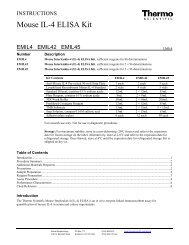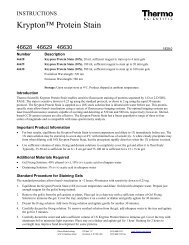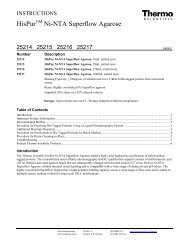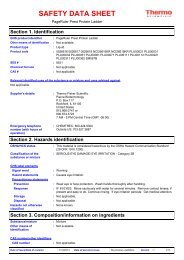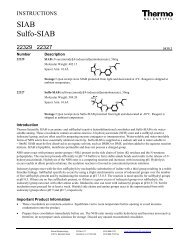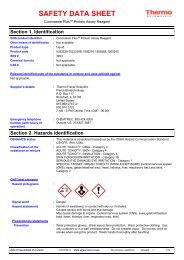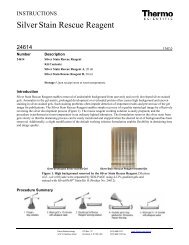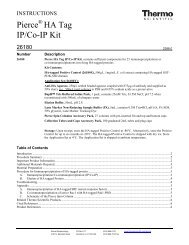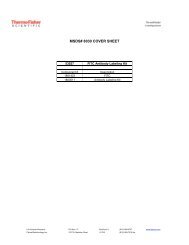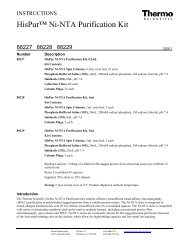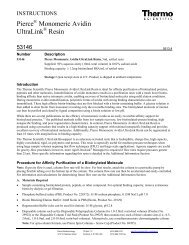EZ-Link Maleimide Activated Horseradish Peroxidase - Pierce
EZ-Link Maleimide Activated Horseradish Peroxidase - Pierce
EZ-Link Maleimide Activated Horseradish Peroxidase - Pierce
You also want an ePaper? Increase the reach of your titles
YUMPU automatically turns print PDFs into web optimized ePapers that Google loves.
INSTRUCTIONS<br />
<strong>EZ</strong>-<strong>Link</strong> ® <strong>Maleimide</strong> <strong>Activated</strong><br />
<strong>Horseradish</strong> <strong>Peroxidase</strong><br />
31485<br />
Number<br />
Description<br />
31485 <strong>EZ</strong>-<strong>Link</strong> <strong>Maleimide</strong> <strong>Activated</strong> <strong>Horseradish</strong> <strong>Peroxidase</strong>, 5mg<br />
Note: Total weight is ~25mg as a result of buffer components and salts lyophilized along with the<br />
activated protein<br />
Storage: Upon receipt store product at 4°C. Product is shipped at ambient temperature.<br />
Introduction<br />
The Thermo Scientific <strong>EZ</strong>-<strong>Link</strong> <strong>Maleimide</strong> <strong>Activated</strong> <strong>Horseradish</strong> <strong>Peroxidase</strong> is for preparing horseradish peroxidase (HRP)<br />
conjugates with proteins, peptides and other ligands that contain a free sulfhydryl (–SH) group. HRP has been maleimideactivated<br />
using Sulfo-SMCC, a heterobifunctional crosslinker that contains an N-hydroxysuccinimide ester and a maleimide<br />
group. The activated HRP presents an available maleimide group that can react with sulfhydryl-containing molecules.<br />
Procedure for Conjugating Antibodies to <strong>Maleimide</strong>-activated HRP<br />
Note: This protocol can be modified for molecules other than antibodies that have either a disulfide bond that can be reduced<br />
to generate free –SH groups or an available primary amine so that the required –SH group can be added chemically.<br />
A. Choose either 2-MEA or SATA to Prepare IgG<br />
One of two strategies may be used to ensure that sulfhydryl groups are made available on an antibody for conjugation. One<br />
strategy is to reduce native disulfide bonds in the antibody using 2-mercaptoethylamine•HCl (Method 1), which selectively<br />
cleaves between the heavy chains of IgG. The result is monovalent antibodies with sulfhydryls available for conjugation to<br />
the activated HRP. This method preserves an intact and available antigen-binding site; however, antibody avidity is lowered<br />
as each half antibody has only one binding site.<br />
A second strategy is to add sulfhydryl groups to antibodies with SATA (Method 2), a sulfhydryl-containing modification<br />
reagent that reacts with primary amines (–NH 2 ) present on the side-chain of lysine residues. The reaction results in antibodies<br />
that contain protected sulfhydryl groups, which can be exposed when desired. With this sulfhydryl addition method, there is<br />
no risk of completely reducing and fragmenting antibodies; however, disruption of antigen-binding capability is possible<br />
from modification of antigen-binding sites, especially if binding sites contains many lysine residues.<br />
Note: <strong>Maleimide</strong>s react with sulfhydryls at pH 6.5-7.5 to form stable thioether bonds. At pH values > 7.5, reactivity toward<br />
primary amines and hydrolysis of the maleimide group can occur; however the maleimide group of Sulfo-SMCC is unusually<br />
stable up to pH 7.5.<br />
B. Materials Required<br />
Note: Reagents required for the SATA method are available individually or as a complete kit (i.e., Thermo Scientific<br />
Sulfhydryl Addition Kit, Product No. 23460).<br />
• Phosphate-buffered Saline (PBS): 0.1M sodium phosphate, 0.15M sodium chloride; pH 7.2 (Product No. 28372)<br />
• Antibody: 5mg of IgG in 1mL of PBS<br />
• 2-Mercaptoethylamine•HCl (2-MEA, Product No. 20408) or SATA (Product No. 26102)<br />
• For the SATA reaction, Dimethylformamide (Product No. 20673) is needed for dissolving SATA, and<br />
Hydroxylamine•HCl (Product No. 26103) is needed for deacetylation<br />
• <strong>Maleimide</strong> Conjugation Buffer: 100mM sodium phosphate, 5-10mM EDTA, pH 7.2 (Product No. 77164)<br />
• Desalting column for buffer exchange (e.g., Thermo Scientific Zeba Spin Desalting Column, Product No. 89893)<br />
0645.4<br />
<strong>Pierce</strong> Biotechnology PO Box 117 (815) 968-0747 www.thermoscientific.com/pierce<br />
3747 N. Meridian Road Rockford, lL 61105 USA (815) 968-7316 fax
C. Prepare IgG to Present Sulfhydryl Groups Using Either Method 1 or 2<br />
• Method 1: Partially Reduce Antibodies to Produce Sulfhydryls using 2-MEA<br />
1. Add 100µL of <strong>Maleimide</strong> Conjugation Buffer to a 6mg vial of 2-MEA.<br />
2. Add the prepared IgG to the vial containing the 2-MEA Solution and incubate for 90 minutes at 37°C.<br />
3. Allow solution to cool to room temperature. While the solution is cooling pre-equilibrate a desalting column with<br />
<strong>Maleimide</strong> Conjugation Buffer.<br />
4. Separate 2-MEA from reduced IgG using a desalting column and the <strong>Maleimide</strong> Conjugation Buffer. Collect 0.5mL<br />
fractions. Measure absorbance of each fraction at 280nm to locate the protein peak.<br />
Note: Separation of 2-MEA from reduced IgG is critical, as residual 2-MEA will interfere with coupling. To determine if<br />
adequate separation has been achieved, perform a BCA assay to identify location of 2-MEA (see the Additional<br />
Information Section).<br />
5. Pool fractions that contain reduced IgG. The protein concentration should be ~2.5mg/mL. Immediately proceed to<br />
Section D to minimize disulfide formation.<br />
Note: To precisely determine protein concentration, use the Thermo Scientific Coomassie Plus (Bradford) Assay Kit<br />
(Product No. 23236).<br />
• Method 2: Add Sulfhydryl Groups to Antibodies using SATA<br />
Note: This protocol can be modified for other primary amine-containing molecules.<br />
1. Add 200µL of DMF to 2mg of SATA.<br />
2. Add 20µL of SATA solution to the prepared IgG, which yields a 25-fold molar excess of SATA. Discard unused<br />
reconstituted SATA.<br />
3. Incubate for 30 minutes at room temperature.<br />
Note: The SATA-modified protein contains a protected sulfhydryl and is, therefore, stable and may be stored. Once the<br />
sulfhydryl is deacetylated, conjugation must be performed rapidly to minimize disulfide formation.<br />
4. For deacetylation, add 100µL of <strong>Maleimide</strong> Conjugation Buffer to 5mg of Hydroxylamine•HCl. Add the SATAmodified<br />
IgG to the solution.<br />
5. Incubate for 2 hours at room temperature. During this incubation, pre-equilibrate the desalting column with <strong>Maleimide</strong><br />
Conjugation Buffer.<br />
6. Separate nonreacted SATA from the modified IgG using a desalting column and the <strong>Maleimide</strong> Conjugation Buffer.<br />
Collect 0.5mL fractions. Measure absorbance of each fraction at 280nm to locate the protein peak<br />
Note: Separation of nonreacted SATA from modified IgG is critical as residual SATA will interfere with HRP coupling.<br />
7. Pool fractions that contain the modified IgG. The protein concentration should be ~2.5mg/mL. Immediately proceed to<br />
Section D to minimize disulfide formation.<br />
Note: To precisely determine protein concentration, use the Coomassie Plus (Bradford) Assay Kit (Product No. 23236).<br />
D. Conjugation of IgG to <strong>Maleimide</strong>-activated HRP<br />
This method uses a four-fold molar excess of activated HRP to IgG. For SATA-modified IgG the result will be 1-3 moles of<br />
HRP incorporated per mole of IgG. For 2-MEA-reduced IgG the result will be 1 mole of HRP incorporated per half antibody.<br />
Other molar ratios may be used.<br />
1. Add 2mL of the pooled protein to the vial of activated HRP.<br />
2. Incubate reaction for 1 hour at room temperature. To increase HRP incorporation, extend reaction time up to 12 hours.<br />
3. For long-term storage, remove EDTA from conjugate by dialysis or using a desalting column. Use Thermo Scientific<br />
<strong>Pierce</strong> <strong>Peroxidase</strong> Conjugate Stabilizer (Product No. 31503) or add glycerol to 50% and store at -20°C.<br />
<strong>Pierce</strong> Biotechnology PO Box 117 (815) 968-0747 www.thermoscientific.com/pierce<br />
3747 N. Meridian Road Rockford, lL 61105 USA (815) 968-7316 fax<br />
2
Additional Information<br />
A. Determine Location of Protein and Reducing Reagents by <strong>Pierce</strong> BCA Protein Assay<br />
Separation of 2-MEA from reduced IgG is critical, as residual 2-MEA will interfere with coupling. To determine if adequate<br />
separation has been achieved, perform a protein assay (e.g., Thermo Scientific <strong>Pierce</strong> BCA Protein Assay, Product No.<br />
23225) to identify location of 2-MEA and the HRP conjugate.<br />
1. Place 1mL tubes in a rack and collect fractions as the solution flows through the desalting column.<br />
2. Prepare <strong>Pierce</strong> BCA Working Reagent according to the instructions supplied with the kit. Pipette 200µL of Working<br />
Reagent into one microplate well for each fraction collected.<br />
3. Add 5µL from each fraction to the wells. The 2-MEA will react immediately producing an intense color.<br />
Note: Do not use greater than 5µL of sample, as the EDTA content of the buffer will interfere with the assay.<br />
4. After 15-30 minutes, wells containing protein will turn blue to purple. A blank (or green) well between proteincontaining<br />
samples and 2-MEA indicates excellent separation.<br />
B. Information Available from Our Website<br />
Visit our website for additional information including the following items:<br />
• Tech Tip # 43: Protein stability and storage<br />
• Tech Tip # 6: Extinction coefficients guide<br />
• Tech Tip # 7: Remove air bubbles from columns to restore flow rate<br />
• Tech Tip #29: Degas solutions for use in affinity and gel filtration columns<br />
Related Thermo Scientific Products<br />
89893 Zeba Spin Desalting Columns, 7K MWCO, 10mL, 5/pkg<br />
89894 Zeba Spin Desalting Columns, 7K MWCO, 10mL, 25/pkg<br />
31495 <strong>EZ</strong>-<strong>Link</strong> <strong>Activated</strong> <strong>Peroxidase</strong>, 5mg<br />
34080 SuperSignal ® West Pico Chemiluminescent Substrate, 500mL<br />
34075 SuperSignal West Dura Extended Duration Substrate, 100mL<br />
34095 SuperSignal West Femto Maximum Sensitivity Substrate, 100mL<br />
34090 CL-XPosure Film, 5” × 7” sheets, 100 sheets/pkg<br />
21059 Restore Western Blot Stripping Buffer, 500mL<br />
General References<br />
Duncan, R.J.S., et al. (1983). A new reagent which may be used to introduce sulfhydryl groups into proteins, and its use in the preparation of conjugates for<br />
immunoassay. Anal Biochem 132:68-73.<br />
Hashida, S., et al. (1984). More useful maleimide compounds for the conjugation of Fab' to horseradish peroxidase through thiol groups in the hinge.<br />
J Appl Biochem 6:56-63.<br />
Imagawa, M., et al. (1982). Characteristics and evaluation of antibody- horseradish peroxidase conjugates prepared by using a maleimide compound,<br />
glutaraldehyde, and periodate. J Appl Biochem 4:41-57.<br />
Yoshitake, S., et al. (1979). Conjugation of glucose oxidase from Aspergillus niger and rabbit antibodies using N-hydroxysuccinimide ester of N-(4-<br />
carboxycyclohexyl-methyl) maleimide. Eur J Biochem 101:395-9.<br />
<strong>Pierce</strong> Biotechnology PO Box 117 (815) 968-0747 www.thermoscientific.com/pierce<br />
3747 N. Meridian Road Rockford, lL 61105 USA (815) 968-7316 fax<br />
3
This product (“Product”) is warranted to operate or perform substantially in conformance with published Product specifications in effect at the time of sale,<br />
as set forth in the Product documentation, specifications and/or accompanying package inserts (“Documentation”) and to be free from defects in material and<br />
workmanship. Unless otherwise expressly authorized in writing, Products are supplied for research use only. No claim of suitability for use in applications<br />
regulated by FDA is made. The warranty provided herein is valid only when used by properly trained individuals. Unless otherwise stated in the<br />
Documentation, this warranty is limited to one year from date of shipment when the Product is subjected to normal, proper and intended usage. This<br />
warranty does not extend to anyone other than the original purchaser of the Product (“Buyer”).<br />
No other warranties, express or implied, are granted, including without limitation, implied warranties of merchantability, fitness for any particular<br />
purpose, or non infringement. Buyer’s exclusive remedy for non-conforming Products during the warranty period is limited to replacement of or<br />
refund for the non-conforming Product(s).<br />
There is no obligation to replace Products as the result of (i) accident, disaster or event of force majeure, (ii) misuse, fault or negligence of or by Buyer, (iii)<br />
use of the Products in a manner for which they were not designed, or (iv) improper storage and handling of the Products.<br />
Current product instructions are available at www.thermoscientific.com/pierce. For a faxed copy, call 800-874-3723 or contact your local distributor.<br />
© 2012 Thermo Fisher Scientific Inc. All rights reserved. Unless otherwise indicated, all trademarks are property of Thermo Fisher Scientific Inc. and its<br />
subsidiaries. Printed in the USA.<br />
<strong>Pierce</strong> Biotechnology PO Box 117 (815) 968-0747 www.thermoscientific.com/pierce<br />
3747 N. Meridian Road Rockford, lL 61105 USA (815) 968-7316 fax<br />
4



